A Brief Review on Solvent-Free Synthesis of Zeolites
Abstract
:1. Introduction
2. Vapor-Phase Transport Technology
3. Solvent-Free Synthesis of Zeolite
4. Formation of Hierarchical Pore Structure
4.1. Bottom-Up Strategy
4.2. Up–Down Strategy
5. Synthesis of Zeolites with Different Morphologies
6. Mechanism on Zeolite Synthesis
7. Applications of Solvent-Free Zeolite
8. Conclusions and Perspective
Author Contributions
Funding
Institutional Review Board Statement
Informed Consent Statement
Data Availability Statement
Conflicts of Interest
Nomenclature
| 27Al 2D MQMAS NMR | 27Al two-dimensional multiple-quantum magic-angle spinning nuclear magnetic resonance |
| 27Al MAS NMR | 27Al magic-angle spinning nuclear magnetic resonance |
| 29Si NMR | 29Si nuclear magnetic resonance |
| 4R | Four-membered rings |
| 6R | Six-membered rings |
| 8R | Eight-membered rings |
| Al | Aluminum |
| C5+ | Gasoline-range hydrocarbons |
| CTAB | Cetyltrimethylammonium bromide |
| DGC | Dry-gel conversion |
| DPA | Di-n-propylamine |
| DPA·H3PO4 | Di-n-propylamine phosphate |
| EtOH | Ethanol |
| FA | Furfuryl alcohol |
| Fe | Iron |
| GO | Graphene oxide |
| IZA | International zeolite association |
| Mg | Magnesium |
| MTG | Methanol to gasoline |
| MTO | Methanol to olefins |
| Na2SiO3 | Sodium silicate |
| NaAlO2 | Sodium aluminate |
| NaCl | Sodium chloride |
| NaOH | Sodium hydroxide |
| Na2SiO3·9H2O | Sodium metasilicate nonahydrate |
| NH3 | Ammonia |
| NH4Cl | Ammonium chloride |
| NH4F | Ammonium fluoride |
| NH4HCO3 | Ammonium bicarbonate |
| (NH4)2SiF6 | Ammonium silicofluoride |
| O | Oxygen |
| SDA | Structure-directing agent |
| SEM | Scanning electron microscope |
| Si | Silicon |
| SiO2 | Silica |
| TEM | Transmission electron microscope |
| VPT | Vapor-phase transport |
| XRD | X-ray diffraction |
References
- Corma, A. Inorganic solid acids and their use in acid-catalyzed hydrocarbon reactions. Chem. Rev. 1995, 95, 559–614. [Google Scholar] [CrossRef]
- Corma, A. From microporous to mesoporous molecular sieve materials and their use in catalysis. Chem. Rev. 1997, 97, 2373–2420. [Google Scholar] [CrossRef]
- Davis, M.E. Ordered porous materials for emerging applications. Nature 2002, 417, 813–821. [Google Scholar] [CrossRef]
- Li, Y.; Li, L.; Yu, J. Applications of zeolites in sustainable chemistry. Chem 2017, 3, 928–949. [Google Scholar] [CrossRef] [Green Version]
- Amorim, R.; Vilaça, N.l.; Martinho, O.; Reis, R.M.; Sardo, M.; Rocha, J.o.; Fonseca, A.n.M.; Baltazar, F.t.; Neves, I.C. Zeolite structures loading with an anticancer compound as drug delivery systems. J. Phys. Chem. C 2012, 116, 25642–25650. [Google Scholar] [CrossRef] [Green Version]
- Corma, A.; Iborra, S.; Velty, A. Chemical routes for the transformation of biomass into chemicals. Chem. Rev. 2007, 107, 2411–2502. [Google Scholar] [CrossRef]
- Tao, Y.; Kanoh, H.; Kaneko, K. ZSM-5 monolith of uniform mesoporous channels. J. Am. Chem. Soc. 2003, 125, 6044–6045. [Google Scholar] [CrossRef] [PubMed]
- Ohlin, L.; Bazin, P.; Thibault-Starzyk, F.; Hedlund, J.; Grahn, M. Adsorption of CO2, CH4, and H2O in zeolite ZSM-5 studied using in situ ATR-FTIR spectroscopy. J. Phys. Chem. C 2013, 117, 16972–16982. [Google Scholar] [CrossRef]
- Valtchev, V.; Tosheva, L. Porous nanosized particles: Preparation, properties, and applications. Chem. Rev. 2013, 113, 6734–6760. [Google Scholar] [CrossRef]
- Fiorillo, A.S.; Tiriolo, R.; Pullano, S.A. Absorption of urea into zeolite layer integrated with microelectronic circuits. IEEE Trans. Nanotechnol. 2014, 14, 214–217. [Google Scholar] [CrossRef]
- Fiorillo, A.; Pullano, S.; Rudenko, S.; Stetsenko, M.; Maksimenko, L.; Krishchenko, I.; Synyuk, V. Antireflection properties of composite zeolite gold nanoparticles film. Electron. Lett. 2018, 54, 370–372. [Google Scholar] [CrossRef]
- Johnson, E.B.G.; Arshad, S.E. Hydrothermally synthesized zeolites based on kaolinite: A review. Appl. Clay. Sci. 2014, 97–98, 215–221. [Google Scholar] [CrossRef]
- Rabenau, A. The role of hydrothermal synthesis in preparative chemistry. Angew. Chem. Int. Ed. 1985, 24, 1026–1040. [Google Scholar] [CrossRef]
- Meng, X.; Xiao, F.-S. Green routes for synthesis of zeolites. Chem. Rev. 2014, 114, 1521–1543. [Google Scholar] [CrossRef] [PubMed]
- Hari, P.; Rao, P.; Matsukata, M. Dry-gel conversion technique for synthesis of zeolite BEA. Chem. Commun. 1996, 1441–1442. [Google Scholar] [CrossRef]
- Wu, Q.; Wang, X.; Qi, G.; Guo, Q.; Pan, S.; Meng, X.; Xu, J.; Deng, F.; Fan, F.; Feng, Z. Sustainable synthesis of zeolites without addition of both organotemplates and solvents. J. Am. Chem. Soc. 2014, 136, 4019–4025. [Google Scholar] [CrossRef] [PubMed]
- Xu, W.; Dong, J.; Li, J.; Li, J.; Wu, F. A novel method for the preparation of zeolite ZSM-5. J. Chem. Soc. Chem. Commun. 1990, 755–756. [Google Scholar] [CrossRef]
- Althoff, R.; Unger, K.; Schüth, F. Is the formation of a zeolite from a dry powder via a gas phase transport process possible? Microporous Mater. 1994, 2, 557–562. [Google Scholar] [CrossRef]
- Ren, L.; Wu, Q.; Yang, C.; Zhu, L.; Li, C.; Zhang, P.; Zhang, H.; Meng, X.; Xiao, F.S. Solvent-free synthesis of zeolites from solid raw materials. J. Am. Chem. Soc. 2012, 134, 15173–15176. [Google Scholar] [CrossRef]
- Naik, S.P.; Chiang, A.S.; Thompson, R. Synthesis of zeolitic mesoporous materials by dry gel conversion under controlled humidity. J. Phys. Chem. B 2003, 107, 7006–7014. [Google Scholar] [CrossRef]
- Matsukata, M.; Ogura, M.; Osaki, T.; Rao, P.R.H.P.; Nomura, M.; Kikuchi, E. Conversion of dry gel to microporous crystals in gas phase. Top. Catal. 1999, 9, 77–92. [Google Scholar] [CrossRef]
- Kim, M.-H.; Li, H.-X.; Davis, M.E. Synthesis of zeolites by water-organic vapor-phase transport. Microporous Mater. 1993, 1, 191–200. [Google Scholar] [CrossRef]
- Nishiyama, N.; Ueyama, K.; Matsukata, M. Synthesis of defect-free zeolite-alumina composite membranes by a vapor-phase transport method. Microporous Mater. 1996, 7, 299–308. [Google Scholar] [CrossRef]
- Wu, Q.; Liu, X.; Zhu, L.; Ding, L.; Gao, P.; Wang, X.; Pan, S.; Bian, C.; Meng, X.; Xu, J.; et al. Solvent-free synthesis of zeolites from anhydrous starting raw solids. J. Am. Chem. Soc. 2015, 137, 1052–1055. [Google Scholar] [CrossRef] [PubMed]
- Gao, W.; Amoo, C.C.; Zhang, G.; Javed, M.; Mazonde, B.; Lu, C.; Yang, R.; Xing, C.; Tsubaki, N. Insight into solvent-free synthesis of MOR zeolite and its laboratory scale production. Microporous Mesoporous Mater. 2019, 280, 187–194. [Google Scholar] [CrossRef]
- Nada, M.H.; Larsen, S.C.; Gillan, E.G. Mechanochemically-assisted solvent-free and template-free synthesis of zeolites ZSM-5 and mordenite. Nanoscale Adv. 2019, 1, 3918–3928. [Google Scholar] [CrossRef] [Green Version]
- Nada, M.H.; Gillan, E.G.; Larsen, S.C. Mechanochemical reaction pathways in solvent-free synthesis of ZSM-5. Microporous Mesoporous Mater. 2019, 276, 23–28. [Google Scholar] [CrossRef]
- Jin, Y.; Sun, Q.; Qi, G.; Yang, C.; Xu, J.; Chen, F.; Meng, X.; Deng, F.; Xiao, F.S. Solvent-free synthesis of silicoaluminophosphate zeolites. Angew. Chem. Int. Ed. 2013, 52, 9172–9175. [Google Scholar] [CrossRef]
- Joshi, R.; Zhang, G.; Miller, J.T.; Gounder, R. Evidence for the coordination–insertion mechanism of ethene dimerization at nickel cations exchanged onto beta molecular sieves. Acs Catal. 2018, 8, 11407–11422. [Google Scholar] [CrossRef]
- Fickel, D.W.; Lobo, R.F. Copper coordination in Cu-SSZ-13 and Cu-SSZ-16 investigated by variable-temperature XRD. J. Phys. Chem. C 2010, 114, 1633–1640. [Google Scholar] [CrossRef]
- Narsimhan, K.; Michaelis, V.K.; Mathies, G.; Gunther, W.R.; Griffin, R.G.; Roman-Leshkov, Y. Methane to acetic acid over Cu-exchanged zeolites: Mechanistic insights from a site-specific carbonylation reaction. J. Am. Chem. Soc. 2015, 137, 1825–1832. [Google Scholar] [CrossRef] [PubMed] [Green Version]
- Pappas, D.K.; Borfecchia, E.; Dyballa, M.; Pankin, I.A.; Lomachenko, K.A.; Martini, A.; Signorile, M.; Teketel, S.; Arstad, B.; Berlier, G. Methane to methanol: Structure–activity relationships for Cu-CHA. J. Am. Chem. Soc. 2017, 139, 14961–14975. [Google Scholar] [CrossRef] [Green Version]
- Ryu, T.; Ahn, N.H.; Seo, S.; Cho, J.; Kim, H.; Jo, D.; Park, G.T.; Kim, P.S.; Kim, C.H.; Bruce, E.L. Fully copper-exchanged high-silica LTA zeolites as unrivaled hydrothermally stable NH3-SCR catalysts. Angew. Chem. Int. Ed. 2017, 129, 3304–3308. [Google Scholar] [CrossRef] [Green Version]
- Ma, Y.; Han, S.; Wu, Q.; Zhu, L.; Luan, H.; Meng, X.; Xiao, F.-S. One-pot fabrication of metal-zeolite catalysts from a combination of solvent-free and sodium-free routes. Catal. Today 2020. [Google Scholar] [CrossRef]
- Kwak, J.H.; Tonkyn, R.G.; Kim, D.H.; Szanyi, J.; Peden, C.H. Excellent activity and selectivity of Cu-SSZ-13 in the selective catalytic reduction of NOx with NH3. J. Catal. 2010, 275, 187–190. [Google Scholar] [CrossRef]
- Wang, T.; Yang, C.; Li, S.; Yu, G.; Liu, Z.; Wang, H.; Gao, P.; Sun, Y. Solvent-free synthesis of Mg-incorporated nanocrystalline SAPO-34 zeolites via natural clay for chloromethane-to-olefin conversion. ACS Sustain. Chem. Eng. 2020, 8, 4185–4193. [Google Scholar] [CrossRef]
- Liu, Z.; Nomura, N.; Nishioka, D.; Hotta, Y.; Matsuo, T.; Oshima, K.; Yanaba, Y.; Yoshikawa, T.; Ohara, K.; Kohara, S. A top-down methodology for ultrafast tuning of nanosized zeolites. Chem. Commun. 2015, 51, 12567–12570. [Google Scholar] [CrossRef]
- Přech, J.; Pizarro, P.; Serrano, D.; Čejka, J. From 3D to 2D zeolite catalytic materials. Chem. Soc. Rev. 2018, 47, 8263–8306. [Google Scholar] [CrossRef] [Green Version]
- Zhang, K.; Ostraat, M.L. Innovations in hierarchical zeolite synthesis. Catal. Today 2016, 264, 3–15. [Google Scholar] [CrossRef]
- Jin, Y.; Chen, X.; Sun, Q.; Sheng, N.; Liu, Y.; Bian, C.; Chen, F.; Meng, X.; Xiao, F.S. Solvent-free syntheses of hierarchically porous aluminophosphate-based zeolites with AEL and AFI structures. Chem. Eur. J. 2014, 20, 17616–17623. [Google Scholar] [CrossRef]
- Sheng, N.; Xu, H.; Liu, X.; Chu, Y.; Han, S.; Meng, X.; Liu, Y.; Liu, C.; Xiao, F.-S. Self-formation of hierarchical SAPO-11 molecular sieves as an efficient hydroisomerization support. Catal. Today 2020, 350, 165–170. [Google Scholar] [CrossRef]
- Zeng, S.; Wang, R.; Li, A.; Huang, W.; Zhang, Z.; Qiu, S. Solvent-free synthesis of nanosized hierarchical sodalite zeolite with a multi-hollow polycrystalline structure. CrystEngComm 2016, 18, 6779–6783. [Google Scholar] [CrossRef]
- Li, H.; Liu, X.; Qi, S.; Xu, L.; Shi, G.; Ding, Y.; Yan, X.; Huang, Y.; Geng, J. Graphene oxide facilitates solvent-free synthesis of well-dispersed, faceted zeolite crystals. Angew. Chem. Int. Ed. 2017, 56, 14090–14095. [Google Scholar] [CrossRef]
- Maghfirah, A.; Ilmi, M.M.; Fajar, A.T.N.; Kadja, G.T.M. A review on the green synthesis of hierarchically porous zeolite. Mater. Today Chem. 2020, 17. [Google Scholar] [CrossRef]
- Nichterwitz, M.; Grätz, S.; Nickel, W.; Borchardt, L. Solvent-free hierarchization of zeolites by carbochlorination. J. Mater. Chem. A 2017, 5, 221–229. [Google Scholar] [CrossRef] [Green Version]
- Liu, Z.; Ren, S.; Yu, X.; Chen, X.; Wang, G.; Wu, X.; Yu, G.; Qiu, M.; Yang, C.; Sun, Y. Melting-assisted solvent-free synthesis of hierarchical SAPO-34 with enhanced methanol to olefins (MTO) performance. Catal. Sci. Technol. 2018, 8, 423–427. [Google Scholar] [CrossRef]
- Yu, G.; Chen, X.; Xue, W.; Ge, L.; Wang, T.; Qiu, M.; Wei, W.; Gao, P.; Sun, Y. Melting-assisted solvent-free synthesis of SAPO-11 for improving the hydroisomerization performance of n-dodecane. Chin. J. Catal. 2020, 41, 622–630. [Google Scholar] [CrossRef]
- Seo, Y.; Lee, S.; Jo, C.; Ryoo, R. Microporous aluminophosphate nanosheets and their nanomorphic zeolite analogues tailored by hierarchical structure-directing amines. J. Am. Chem. Soc. 2013, 135, 8806–8809. [Google Scholar] [CrossRef]
- Kodaira, T.; Nabata, A.; Ikeda, T. A new aluminophosphate phase, AlPO-NS, with a bellows-like morphology obtained from prolonged hydrothermal process or increased pH value of initial solution for synthesizing AlPO4-5. Microporous Mesoporous Mater. 2012, 162, 31–35. [Google Scholar] [CrossRef]
- Wu, L.; Liu, Z.; Xia, L.; Qiu, M.; Liu, X.; Zhu, H.; Sun, Y. Effect of SAPO-34 molecular sieve morphology on methanol to olefins performance. Chin. J. Catal. 2013, 34, 1348–1356. [Google Scholar] [CrossRef]
- Wu, D.; Yu, X.; Chen, X.; Yu, G.; Zhang, K.; Qiu, M.; Xue, W.; Yang, C.; Liu, Z.; Sun, Y. Morphology-controlled synthesis of H-type MFI zeolites with unique stacked structures through a one-pot solvent-free Strategy. ChemSusChem 2019, 12, 3871–3877. [Google Scholar] [CrossRef]
- Li, S.; Li, J.; Dong, M.; Fan, S.; Zhao, T.; Wang, J.; Fan, W. Strategies to control zeolite particle morphology. Chem. Soc. Rev. 2019, 48, 885–907. [Google Scholar] [CrossRef]
- Zhang, J.; Lu, X.; Wang, Z. Control of crystallization rate and morphology of zeolite silicalite-1 in solvent-free synthesis. Microporous Mesoporous Mater. 2019, 283, 14–24. [Google Scholar] [CrossRef]
- Chen, X.; Meng, X.; Xiao, F.-S. Solvent-free synthesis of SAPO-5 zeolite with plate-like morphology in the presence of surfactants. Chin. J. Catal. 2015, 36, 797–800. [Google Scholar] [CrossRef]
- Yu, X.; Zhou, C.; Chen, X.; Gao, P.; Qiu, M.; Xue, W.; Yang, C.; Zhao, H.; Liu, H.; Liu, Z.; et al. Facile solvent-free synthesis of hollow fiber catalyst assembled by c-axis oriented ZSM-5 crystals. ChemCatChem 2018, 10, 5619–5626. [Google Scholar] [CrossRef]
- Liu, Z.; Wu, D.; Ren, S.; Chen, X.; Qiu, M.; Wu, X.; Yang, C.; Zeng, G.; Sun, Y. Solvent-free synthesis of c-axis oriented ZSM-5 crystals with enhanced methanol to gasoline catalytic activity. ChemCatChem 2016, 8, 3317–3322. [Google Scholar] [CrossRef]
- Li, D.; Qiu, L.; Wang, K.; Zeng, Y.; Williams, T.; Huang, Y.; Tsapatsis, M.; Wang, H. Growth of zeolite crystals with graphene oxide nanosheets. Chem. Commun. 2012, 48, 2249–2251. [Google Scholar] [CrossRef] [PubMed]
- Chen, L.-H.; Li, X.-Y.; Rooke, J.C.; Zhang, Y.-H.; Yang, X.-Y.; Tang, Y.; Xiao, F.-S.; Su, B.-L. Hierarchically structured zeolites: Synthesis, mass transport properties and applications. J. Mater. Chem. 2012, 22, 17381–17403. [Google Scholar] [CrossRef]
- Morris, R.E.; James, S.L. Solventless synthesis of zeolites. Angew. Chem. Int. Ed. 2013, 52, 2163–2165. [Google Scholar] [CrossRef]
- Xiao, Y.; Sheng, N.; Chu, Y.; Wang, Y.; Wu, Q.; Liu, X.; Deng, F.; Meng, X.; Feng, Z. Mechanism on solvent-free crystallization of NaA zeolite. Microporous Mesoporous Mater. 2017, 237, 201–209. [Google Scholar] [CrossRef]
- Wang, X.; Wu, Q.; Chen, C.; Pan, S.; Zhang, W.; Meng, X.; Maurer, S.; Feyen, M.; Muller, U.; Xiao, F.S. Atom-economical synthesis of a high silica CHA zeolite using a solvent-free route. Chem. Commun. 2015, 51, 16920–16923. [Google Scholar] [CrossRef] [PubMed]
- Liu, Z.; Wu, D.; Ren, S.; Chen, X.; Qiu, M.; Liu, G.; Zeng, G.; Sun, Y. Facile one-pot solvent-free synthesis of hierarchical ZSM-5 for methanol to gasoline conversion. RSC Adv. 2016, 6, 15816–15820. [Google Scholar] [CrossRef]
- Zhang, C.; Wu, Q.; Lei, C.; Pan, S.; Bian, C.; Wang, L.; Meng, X.; Xiao, F.-S. Solvent-free and mesoporogen-free synthesis of mesoporous aluminosilicate ZSM-5 zeolites with superior catalytic properties in the methanol-to-olefins reaction. Ind. Eng. Chem. Res. 2017, 56, 1450–1460. [Google Scholar] [CrossRef]
- Nada, M.H.; Larsen, S.C.; Gillan, E.G. Solvent-free synthesis of crystalline ZSM-5 zeolite: Investigation of mechanochemical pre-reaction impact on growth of thermally stable zeolite structures. Solid State Sci. 2019, 94, 15–22. [Google Scholar] [CrossRef]
- Zhang, B.; Douthwaite, M.; Liu, Q.; Zhang, C.; Wu, Q.; Shi, R.; Wu, P.; Liu, K.; Wang, Z.; Lin, W. Seed-and solvent-free synthesis of ZSM-5 with tuneable Si/Al ratios for biomass hydrogenation. Green Chem. 2020, 22, 1630–1638. [Google Scholar] [CrossRef]
- Bian, C.; Zhang, C.; Pan, S.; Chen, F.; Zhang, W.; Meng, X.; Maurer, S.; Dai, D.; Parvulescu, A.-N.; Müller, U. Generalized high-temperature synthesis of zeolite catalysts with unpredictably high space-time yields (STYs). J. Mater. Chem. A 2017, 5, 2613–2618. [Google Scholar] [CrossRef]
- Kornas, A.; Olszówka, J.E.; Urbanova, M.; Mlekodaj, K.; Brabec, L.; Rathousky, J.; Dedecek, J.; Pashkova, V. Milling activation for the solvent-free synthesis of the zeolite mordenite. Eur. J. Inorg. Chem. 2020, 2020, 2791–2797. [Google Scholar] [CrossRef]
- Zhu, L.; Zhang, J.; Wang, L.; Wu, Q.; Bian, C.; Pan, S.; Meng, X.; Xiao, F.-S. Solvent-free synthesis of titanosilicate zeolites. J. Mater. Chem. A 2015, 3, 14093–14095. [Google Scholar] [CrossRef]
- Zhai, H.; Bian, C.; Yu, Y.; Zhu, L.; Guo, L.; Wang, X.; Yu, Q.; Zhu, J.; Cao, X. Sustainable route for synthesis of all-silica SOD zeolite. Crystals 2019, 9, 338. [Google Scholar] [CrossRef] [Green Version]
- Liu, Y.; Lyu, Y.; Zhao, X.; Xu, L.; Mintova, S.; Yan, Z.; Liu, X. Silicoaluminophosphate-11 (SAPO-11) molecular sieves synthesized via a grinding synthesis method. Chem. Commun. 2018, 54, 10950–10953. [Google Scholar] [CrossRef]
- Shan, Y.; Shi, X.; Du, J.; Yan, Z.; Yu, Y.; He, H. SSZ-13 synthesized by solvent-free method: A potential candidate for NH3-SCR catalyst with high activity and hydrothermal stability. Ind. Eng. Chem. Res. 2019, 58, 5397–5403. [Google Scholar] [CrossRef]
- Wu, Q.; Liu, X.; Zhu, L.; Meng, X.; Deng, F.; Fan, F.; Feng, Z.; Li, C.; Maurer, S.; Feyen, M. Solvent-free synthesis of ITQ-12, ITQ-13, and ITQ-17 zeolites. Chin. J. Chem. 2017, 35, 572–576. [Google Scholar] [CrossRef]
- Cheng, S.; Zhang, G.; Javed, M.; Gao, W.; Mazonde, B.; Zhang, Y.; Lu, C.; Yang, R.; Xing, C. Solvent-free synthesis of 1D cancrinite zeolite for unexpectedly improved gasoline selectivity. Chemistryselect 2018, 3, 2115–2119. [Google Scholar] [CrossRef]
- Wang, Y.; Zhang, J.; Meng, X.; Han, S.; Zhu, Q.; Sheng, N.; Wang, L.; Xiao, F.-S. Sustainable and efficient synthesis of nanosized EMT zeolites under solvent-free and organotemplate-free conditions. Microporous Mesoporous Mater. 2019, 286, 105–109. [Google Scholar] [CrossRef]
- Xu, H.; Zhu, J.; Qiao, J.; Yu, X.; Sun, N.-B.; Bian, C.; Li, J.; Zhu, L. Solvent-free synthesis of aluminosilicate SSZ-39 zeolite. Microporous Mesoporous Mater. 2020, 312, 110736. [Google Scholar] [CrossRef]
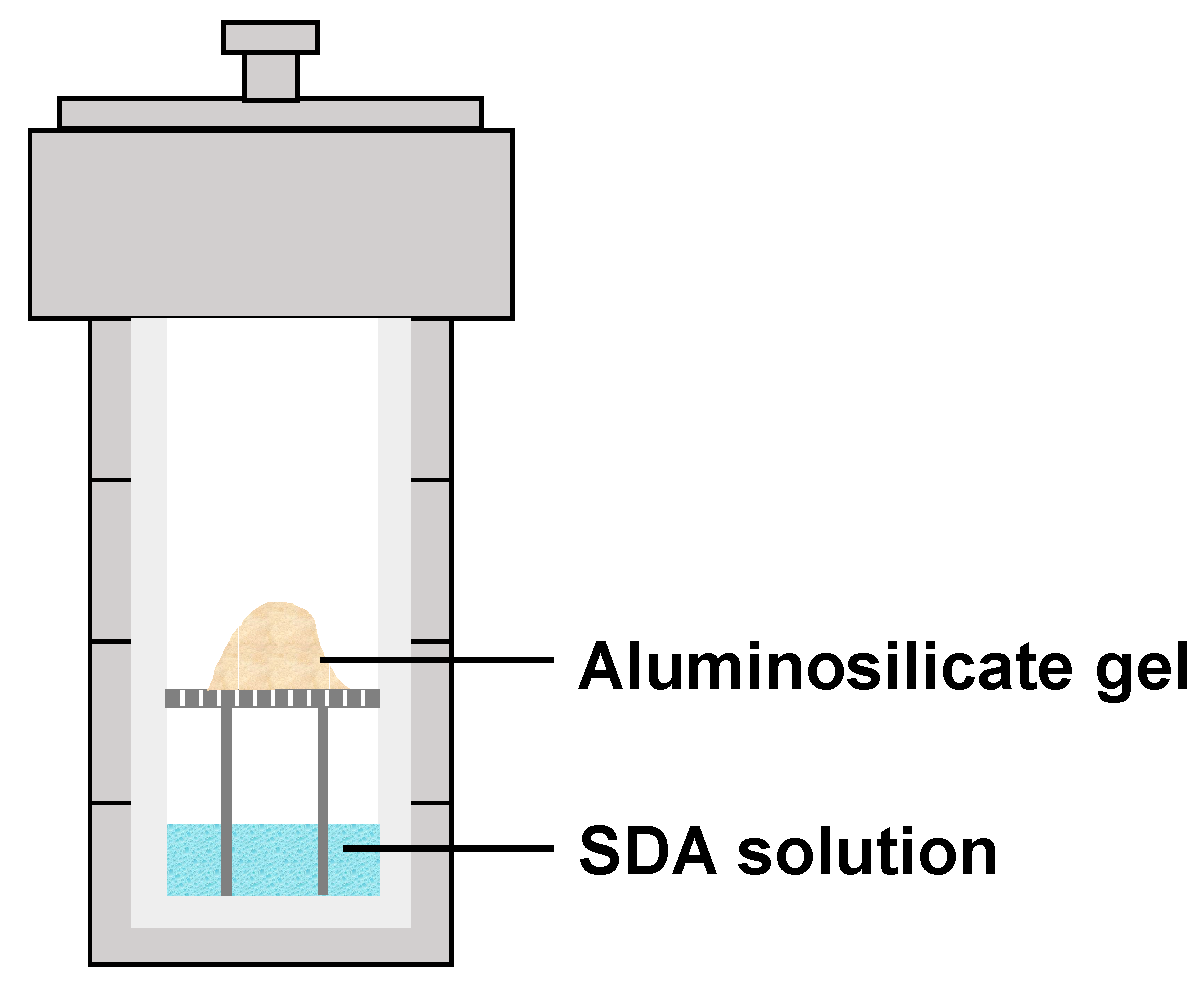
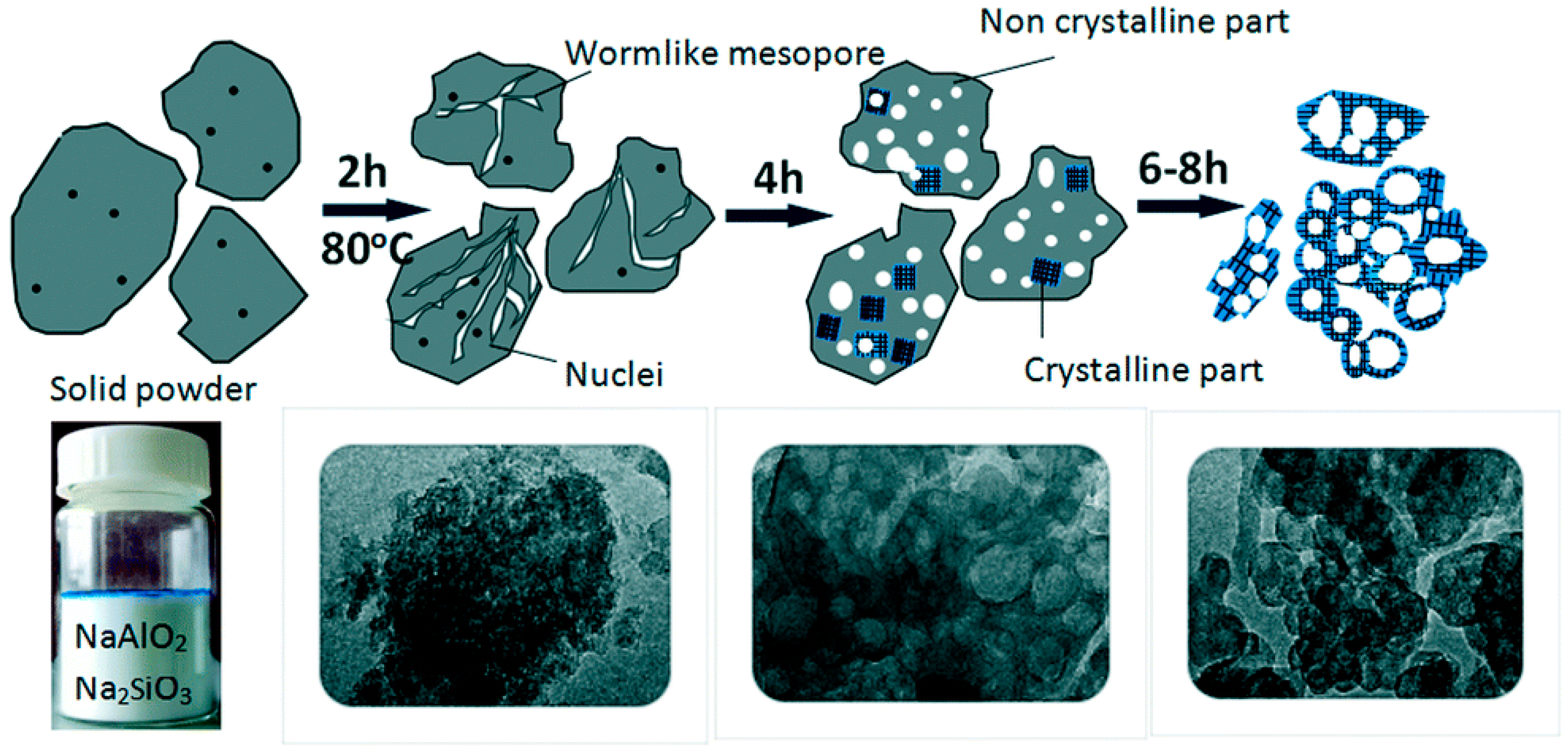
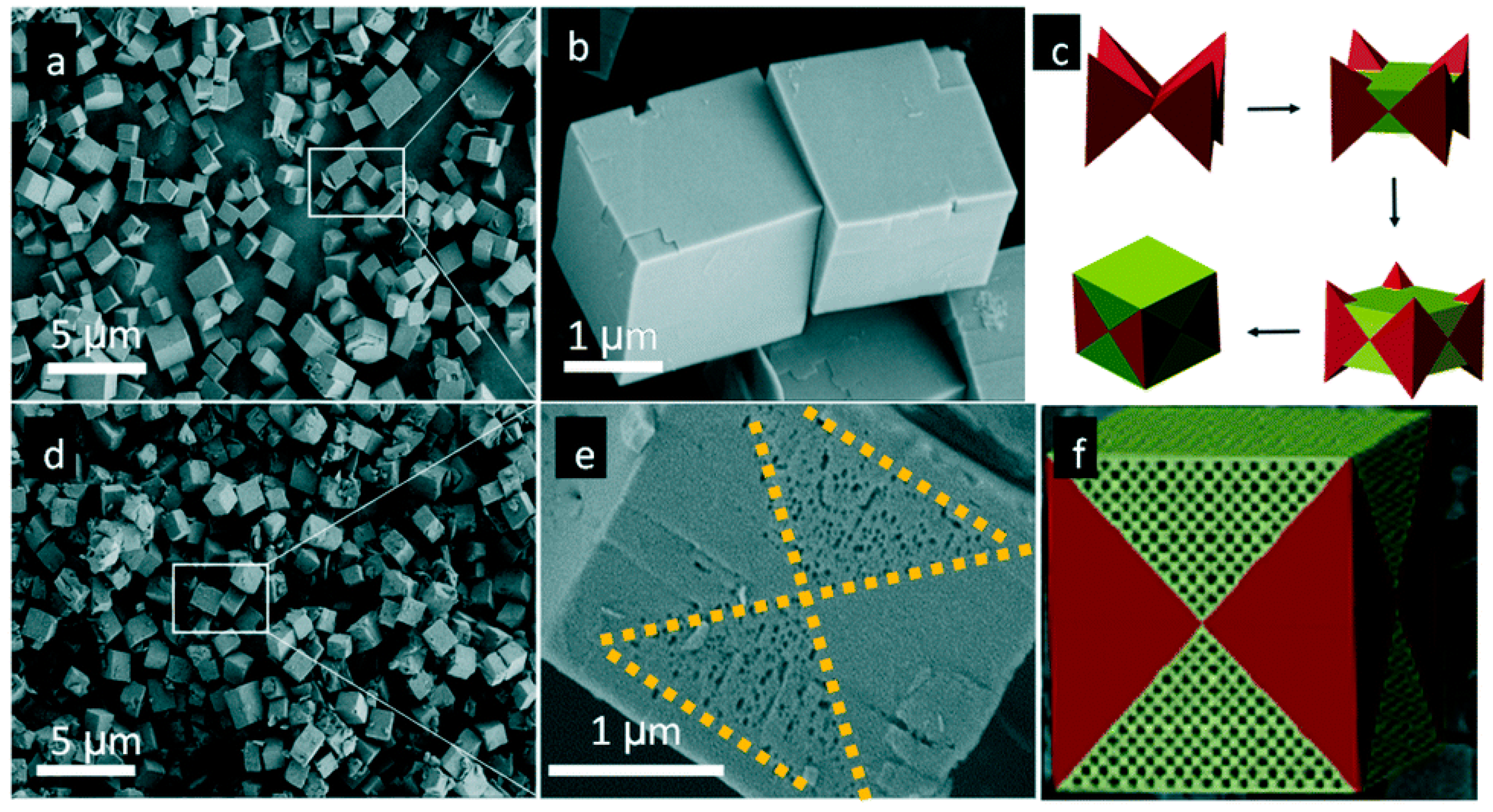
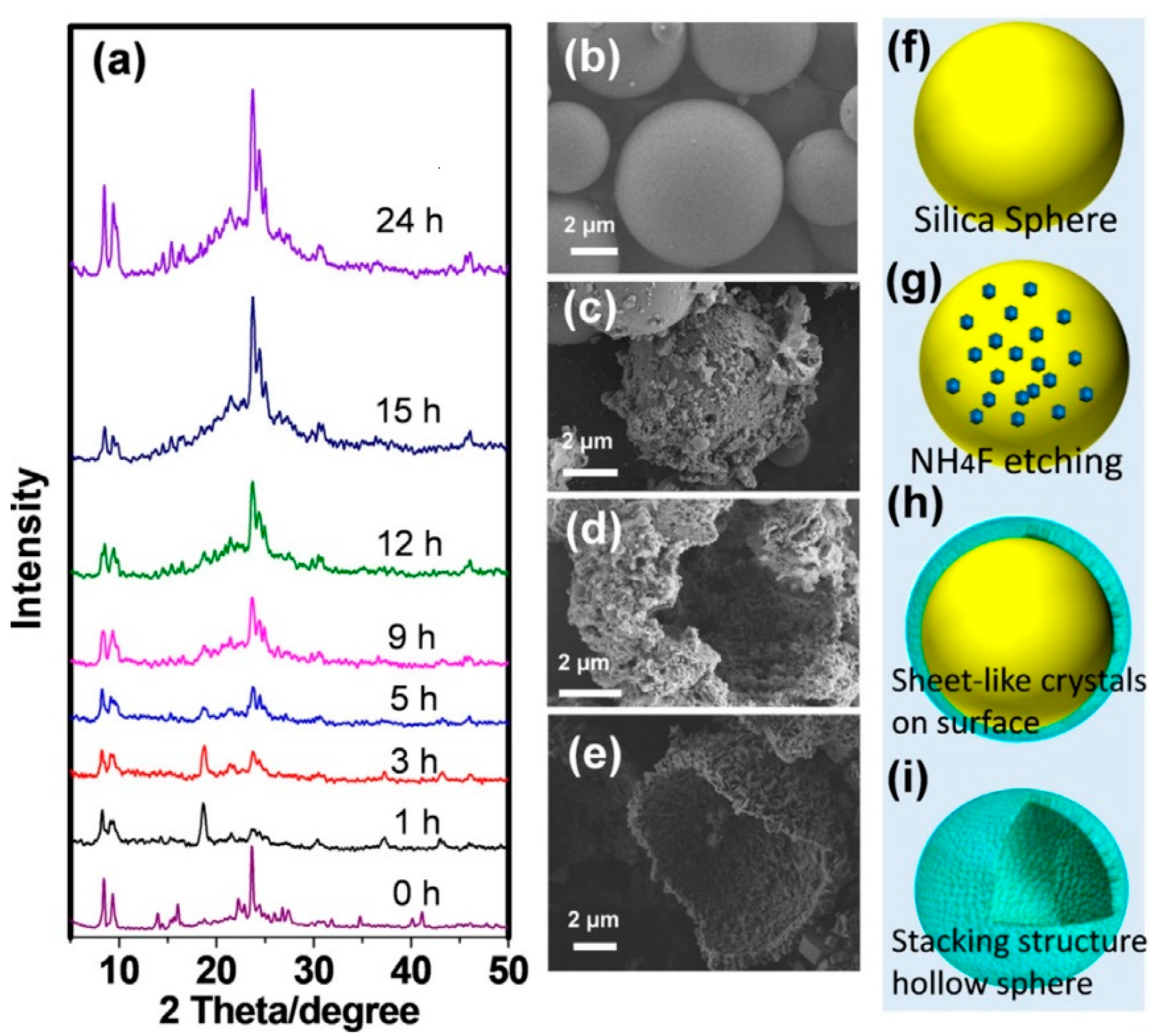
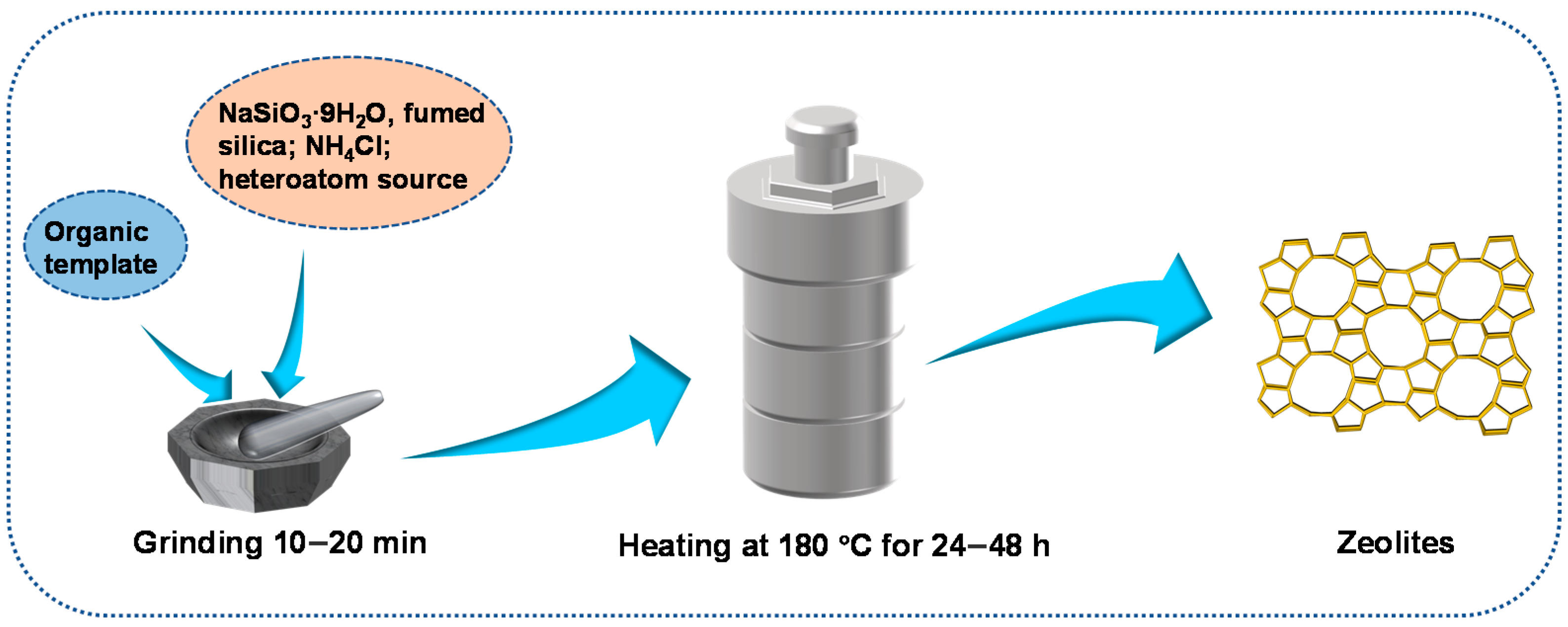

| Zeolite | IZA Code | Dimension | Crystal System | Space Group | Reference |
|---|---|---|---|---|---|
| ZSM-5 | MFI | 3 | orthorhombic | P n m a | [16,19,24,43,51,64,65,66] |
| silicalite-1 | MFI | 3 | orthorhombic | P n m a | [19,53] |
| Beta | *BEA | 3 | tetragonal | P 41 2 2 | [16,24,66] |
| Y | FAU | 3 | cubic | F d m | [19] |
| ZSM-39 | MTN | 0 | cubic | F d m | [19] |
| EU-1 | EUO | 1 | orthorhombic | C m m e | [24] |
| ZSM-22 | TON | 1 | orthorhombic | C m c m | [24] |
| Mordenite | MOR | 2 | orthorhombic | C m c m | [25,66,67] |
| TS-1 | MFI | 3 | orthorhombic | P n m a | [68] |
| sodalite | SOD | 0 | cubic | I m m | [19,42,69] |
| A | LTA | 3 | cubic | P m m | [60] |
| SAPO-34 | CHA | 3 | trigonal | R m | [28] |
| SAPO-43 | SOD | 0 | cubic | I m m | [28] |
| SAPO-20 | GIS | 3 | tetragonal | I 41/a m d | [28] |
| SAPO-11 | AEL | 1 | orthorhombic | I m m a | [28,40,70] |
| SAPO-5 | AFL | 1 | hexagonal | P 6/m c c | [40,54] |
| SSZ-13 | CHA | 3 | trigonal | R m | [61,71] |
| ITQ-12 | ITW | 2 | monoclinic | C1 2/m 1 | [72] |
| ITQ-13 | ITH | orthorhombic | A m m 2 | [72] | |
| ITQ-17 | BEC | 3 | tetragonal | P 42/m m c | [72] |
| Cancrinite | CAN | 1 | hexagonal | P 63/m m c | [73] |
| Na-EMT | EMT | 3 | hexagonal | P 63/m m c | [74] |
| SSZ-39 | AEI | 3 | orthorhombic | C m c m | [75] |
Publisher’s Note: MDPI stays neutral with regard to jurisdictional claims in published maps and institutional affiliations. |
© 2021 by the authors. Licensee MDPI, Basel, Switzerland. This article is an open access article distributed under the terms and conditions of the Creative Commons Attribution (CC BY) license (http://creativecommons.org/licenses/by/4.0/).
Share and Cite
Mei, J.; Duan, A.; Wang, X. A Brief Review on Solvent-Free Synthesis of Zeolites. Materials 2021, 14, 788. https://doi.org/10.3390/ma14040788
Mei J, Duan A, Wang X. A Brief Review on Solvent-Free Synthesis of Zeolites. Materials. 2021; 14(4):788. https://doi.org/10.3390/ma14040788
Chicago/Turabian StyleMei, Jinlin, Aijun Duan, and Xilong Wang. 2021. "A Brief Review on Solvent-Free Synthesis of Zeolites" Materials 14, no. 4: 788. https://doi.org/10.3390/ma14040788
APA StyleMei, J., Duan, A., & Wang, X. (2021). A Brief Review on Solvent-Free Synthesis of Zeolites. Materials, 14(4), 788. https://doi.org/10.3390/ma14040788







